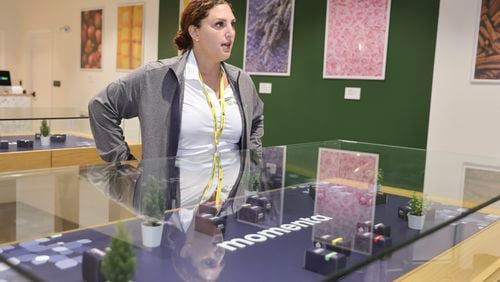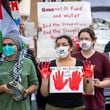Note: This article originally ran on June 10, 1989 as part of the AJC’s award-winning “Suffer the Children” series.
When police arrived, the little girl was still wearing socks soaked in her mother's blood. She had been cradled in her mother's arms when her father burst into their DeKalb County home and shot the woman dead.
The father was later indicted on a murder charge but plea-bargained down to manslaughter, for which he was convicted and sentenced to 12 years in prison.
» "SUFFER THE CHILDREN" SERIES: Full series | Part 1 | Part 2 | Part 3 | Part 4 | Part 5 | Part 6 | Part 7
The question in 1982 of what to do with his 3-year-old daughter - identified only as H.L.T. in court documents - was a simple one for Juvenile Court Judge Edward D. Wheeler. He took one look at the case history - the father's stint in a psychiatric hospital, the pattern of violence that had culminated in the death of his wife - and severed the man's parental rights, freeing the child to be adopted by her aunt and uncle.
The judge reasoned that the little girl had suffered the ultimate deprivation: the violent death of her mother at the hands of her father. And to do anything that could lead to the return of the child to her father "would stretch the bounds of justice beyond the breaking point."
But in Georgia, you can kill your child's mother and still be a worthy parent. At least, that's what the Georgia Court of Appeals decided when it reversed Judge Wheeler's ruling in November 1982. "Compelling facts are required to terminate parental rights," the court ruled. "There is no evidence that appellant had ever abused, injured or failed to provide for his child."
The severing of a parent's right to his child is clearly a weighty matter. But in too many cases, it's not the preservation of family that's at stake, say child welfare experts. It's the preservation of parents' rights to do whatever they want with their children.
Georgia's child protective system does not work. Shielded by confidentiality laws, the bureaucracy's failures are withheld from a public that hears only the occasional story of abuse and has little idea of how encompassing the problems have become.
Yet, even when painted in numbers alone, the crisis is evident - more than 19,000 confirmed reports of abuse and neglect in 1987, 51 children dead last year who were already known to the system and under its "protective" wing.
According to child welfare experts, many of those deaths could have been prevented. The reasons why the system doesn't work are easily identifiable. So are some of the solutions, they say.
But in Georgia, there has been little impetus for change. Experts say that is because children have few advocates, other than their parents. And for abused and neglected children, their parents are often their enemies. These children don't vote. They can't afford good lawyers. They don't contribute to election campaigns.
"Everything that happens in this country is power-oriented," says David S. Liederman, executive director of the Child Welfare League of America. "If all kids have is a few people running around saying, 'This is terrible and we ought to do something,' who gives a damn? And that's a real problem."
Frustration, Stress, Burnout: Risks of the Job
In the halls of Georgia's Capitol this year, lobbyists buttonholed legislators and convinced them to pump in $140 million to relieve overcrowded conditions at the state's jails and prisons. Attorneys for the imprisoned threatened to sue if something wasn't done.
Yet less than five miles from the Statehouse, children were sleeping on the floors of the unregulated Fulton County Emergency Shelter. On some nights during the session, two to three babies were crammed into single cribs. No one threatened to sue for those children.
Judging from the Legislature's response, Georgia's convicted felons can expect to be treated more humanely than abused children. So can some animals. It is a felony in Georgia to kick a police dog. It's normally a misdemeanor to kick a child.
"People are very sensitive to the suffering of animals, but they don't seem to be as sensitive to the suffering of children," says Kathern Bond of the American Humane Association, the nation's first child protective agency, which even today remains better known for its efforts to protect animals than children. "People assume children have their parents to protect them. And I think there are many people who won't believe that an adult would do this to a child."
That lack of sensitivity to children is reflected in the value placed on the people hired to protect them, says Douglas G. Greenwell, director of the state Division of Family and Children Services. The state's child protective service workers - people who are expected to walk into the most unstable of homes, make sophisticated judgments about human nature and exercise enormous control over families - earn starting salaries of $20,000. After nine years on the job, a worker with a master's in social work makes about $25,500 - less than a schoolteacher.
Once on the job, caseworkers get two weeks of training to make decisions that could alter a child's life. They're given unmanageable caseloads of often desperate families. While the Child Welfare League is about to propose national standards for caseworkers that include caseloads of no more than 17 families, some Fulton County caseworkers carry as many as 90.
"I supervise a staff that feels much frustration, high stress levels, burnout and emotional exhaustion," wrote Mary S. Brown, director of the Crisp County Department of Family and Children Services, in a recent letter to state Sen. Pierre Howard. As chairman of the Senate Human Resources Committee, Mr. Howard says he has become alarmed at the welfare system's paralysis in doing its job.
The concern he heard from Mrs. Brown is a common refrain among child welfare administrators, some of whom have seen a turnover rate of 50 percent or more in their staff during the last year. Once caseworkers do decide a child is at risk, often they can't find the services they need to ensure a child's safety.
Federal and state laws dictate that caseworkers must do everything possible to keep families intact - a worthy objective as long as children don't get left behind in dangerous situations. The statistics suggest that too often they do. Caseworkers know what services could minimize the danger, but too often they say those services aren't available.
Parents who physically abuse or neglect their children are generally poor. Among children from families earning annual salaries of less than $15,000, physical neglect is 10 times higher, serious injuries are 7 1/2 times as frequent, sexual abuse is five times greater, and fatalities three times the number found among higher-income families, according to the federal government's 1988 study of the prevalence of child abuse and neglect.
Spectrum of Services Needed, Experts Say
A typical abuse scenario would involve an unemployed father who starts getting collection notices in the mail, turns to drugs and eventually buckles under the stress by beating his 3-month-old baby every time she cries.
The first-line solution is not necessarily to pluck that child from her home, experts say. Rather a spectrum of services should be brought to bear. The father could benefit from job training and drug counseling; the couple from basic training in how to parent a young and demanding infant. A homemaker assigned to the family could assist the parents in getting control of their finances and help walk them through the bureaucracy to get the food stamps they qualify for.
In a New Haven, Conn., program, such services are offered by a team of professionals who work with families in their homes. Operated by Yale University's Child Study Center, the program is contracted by the child welfare department to serve families it has identified as abusive or neglectful of children. After three years, 85 percent of the children who otherwise would have been taken from their families have remained safely at home.
"And it saves the state an enormous amount of money," says Dr. Albert J. Solnit, a child psychiatrist and Sterling professor of pediatrics and psychiatry at Yale.
But there are some families that can never be fixed - many more in Georgia than the state recognizes, if child homicides are a measure.
"Initially, all efforts should be made to pour every resource that can be made available into that family - parenting skills, job training, mental health resources, education services, food, clothing, shelter," says Fulton County Juvenile Court Judge Romae Powell. "That ought to be tried no more than two years. And if they show no effort to change after that, I think their parental rights ought to be terminated. The pathetic thing is by the time we see the kid to terminate parental rights, that child is so damaged and so hurt, that even if he is adopted, he can't form relationships."
Those seriously damaged children are the ones now entering the system in droves. Currently most caseworkers have two choices of where to put children who can no longer stay with family: in emergency shelters, assuming their county has one and it isn't already filled beyond capacity, or in foster families, whose numbers cannot meet the demand.
'There's No Will' to Improve the System
A growing number of the children are so disturbed that they need residential treatment, which is almost non-existent in Georgia. Many of these children's problems are far more serious than a foster family is trained to deal with.
"Some of these youngsters cannot tolerate the closeness of a family," says Dr. Leon A. Rosenberg, a child psychologist at Johns Hopkins University who specializes in child abuse. "It isn't always bad foster parents who grab the phone and scream, 'Get him out of here.' We need to move these kids slowly back into the world of intimate relationships. For them, a good group home is better than foster care."
There's no mystery about what is needed, says Mr. Liederman. "We know enough about the world of child welfare to know what we ought to be doing. But there's no will."
Like other states, Georgia's legislators were quick to pass laws a few years ago mandating that certain professionals report suspected child abuse and neglect. Yet the state failed to provide the programs and people needed to deal with them, according to child welfare workers and their supervisors.
"It's kind of like when we deinstitutionalized mental health institutions, then failed to provide the community services," says Mr. Howard. "And now everyone's wondering how we got so many homeless people."
Studies: Most Inmates Abused as Children
To fix Georgia's child welfare system will clearly cost money. Failing to fix it, of course, could conceivably cost more. Failing to fix it may mean overcrowded jails and prisons that will be assured of a steady clientele in the years to come.
According to the American Humane Association, national studies show that 85 percent to 100 percent of the nation's prison population are adults who were abused or neglected as children.
"Studies have indicated astounding correlations between child abuse and deviant behavior among violent juvenile delinquents and among adults who had committed violent crimes," wrote the National Council of Juvenile and Family Court Judges in a recent report that recommends the overhaul of the nation's child protective service system. "Most violent criminals have been severely physically abused as children."
Child advocates argue that the kind of money that's needed to fix the nation's child welfare systems requires a declaration of financial commitment from the nation's president, its governors and its mayors.
Mr. Liederman points out that last year the federal government allocated $247 million for programs that help keep children out of foster care. Yet it earmarked $40 billion to help bail out the savings and loans institutions, with plans to spend billions more in the next decade.
But even if this state's governor and Legislature decline to make a major new financial commitment, there are a number of things they could do to protect children.
At the top of the list, experts say, should be an overhaul of the way the state responds to children's deaths. The Department of Human Resources's own records show that autopsies are frequently skipped, deaths of children under the department's protection are labeled as sudden infant death syndrome at four times the national rate, and suspicious deaths frequently go unheeded, with no investigation.
In 32 other states, child fatality review teams regularly investigate suspicious child deaths, including those of any child already known to the child welfare agency. The teams are composed not only of representatives from the child welfare agency, but also from the local public health department, police department, district attorney's office and coroner's office.
Around the country, these teams have uncovered invaluable information, prompting new strategies for reform. Minnesota has learned that its caseworkers are inadequately trained and that key players in the child protective system have not been communicating.
Los Angeles and other cities' review teams have begun to put together profiles of families that are most likely to injure their children. They've learned that the children at greatest risk of being killed are babies less than a year old - frequently less than 1 month - and that they're often the children of teenage parents who are poor, unemployed and involved in drugs or alcohol.
"You start tying things down and you require people to talk to each other," says Dr. Michael Durfee, a Los Angeles child psychiatrist recently appointed to the Presidential Commission on Child and Youth Fatalities.
Dr. Durfee says that if Georgia were to create such teams, state child welfare officials would realize that caseworkers need more objective criteria for assessing the danger children are in, deciding when to remove them from their homes and when it is safe to return them. And prosecutors might conclude they need to devote the same amount of zeal to physical abuse and neglect as they now do to sexual abuse.
"I think we are so caught up in sexual abuse for the moment that we have forgotten why the child protective service system in this country was ever set up," says Dr. Richard D. Krugman, executive director of the C. Henry Kempe Center in Denver. "And that was for physical abuse and deaths, plus we continue to neglect neglect."
A Lack of Data on Child Fatalities
For the first time, state officials could begin to define the parameters of the child fatalities problem. In Georgia, no one knows how many children have been beaten to death. The dearth of such data is national in scope.
"The fact that the federal government hasn't made it a priority to try and count these deaths is appalling," says Dr. Krugman. "If you call up the federal government and ask how many Hondas came into the United States this year, they will tell you to the Honda."
Reviews of Georgia's dead children would also underline what many see as a critical need to put medically trained examiners - instead of elected coroners -in charge of death investigations. Today, coroners need only have a high school education, and most have no medical training. Yet they are empowered to say how people died.
Without higher standards for Georgia's coroners, child fatality review teams probably would be a wasted effort. "If the coroner's system is lousy, you can't build the system," says Dr. Durfee.
Weaknesses in other points of the system might also come to light.
Experts say Georgia's teachers and counselors need to be trained in recognizing abused and neglected children, then encouraged to work with child protective service workers once they report such cases. Hospitals should be required by state law to report all drug-addicted infants to child protective services, something they're currently not required to do. Physicians must be more willing to report abuse and testify in court about it, which they are often reluctant to do, according to prosecutors.
Some argue that Georgia's judges also need mandatory training in child development and the signs of physical and sexual abuse and neglect. "There are still many judges who put the sanctity of the family above the rights of the child," says Ms. Bond of the American Humane Association. "They say, 'But this father has a right to be with his child. I don't care if he is sexually abusing her.' "
Finally, child advocates say legislators need to reconsider the entire area of confidentiality, which they say is used as often to protect the system's failures from public scrutiny as it is to protect children's lives.
In death cases, particularly, child advocates question whose interests are served by keeping those records private - the child's? The child is dead. The parents? They may be murderers.
In the state of Washington, when details of the death of 3-year-old Eli Creekmore at the hands of his father became known - he was beaten to death at the dinner table when he could not stop crying - the public was outraged and demanded a more accountable system. Embodied in new legislation is the notion that a child's safety and individual rights must take priority over keeping the family together.
For Many Children, 'A Web of Sadnesss'
Georgia probably has its Eli Creekmores. The public just doesn't know about them.
Ultimately it is up to the community to fix the system, to make it accountable.
The problems of the child welfare system go far beyond the capabilities of the Departments of Family and Children Services to solve. "There are a lot of things that have to occur before we can say we're winning the war," says Gerald V. Gouge, chief of the state's child protective services unit. "One of the things I'd like to see is for the Legislature to outlaw corporal punishment. It would be a significant statement: Children are not objects to take out your anger on."
But attitudes toward children are not likely to change quickly. Those who deal daily with mistreated children say they are hampered most by the public's unwillingness to believe that people do horrible things to their children. It's one thing to see the statistics. It's another to see the children's faces.
In her book, "Orphans," author Eileen Simpson explains why for years on her way to work, she avoided visiting the Hopewell Orphanage in New Jersey, even though she herself had grown up an orphan.
"There was no missing this large red brick building. It stood naked in a field, with neither trees nor shrubs to soften its bulky outline. Whenever I passed it, I said to myself that the next time I must go in and volunteer my professional services. There was surely something I could do for the children. But each time I made an excuse.
"It was fear of being pulled by invisible strings into a web of sadness that made me accelerate rather than slow down on the Hopewell road. For me, the children's eyes would have unspoken messages: 'You were more fortunate than we are,' they would say. Or, more distressingly: 'Take us with you."'





